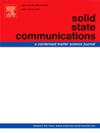Pt、au和ir修饰ZnO纳米管的抗癌氯苯药递送
IF 2.4
4区 物理与天体物理
Q3 PHYSICS, CONDENSED MATTER
引用次数: 0
摘要
利用DFT计算研究了原始ZnO纳米管(ZnONT)和X (X = Pt, Au和Ir)修饰的ZnONT (X@ZnONT)形式作为抗癌氯苯(ChB)药物的给药系统(dds)。纯ZnONT的粘附能(AE)在−5.9 ~−6.8 kcal/mol之间,不适合给药。Pt、Au和Ir在ZnONT上修饰后,AE分别提高到−29.7、−27.1和−30.8 kcal/mol。在X@ZnONT中,X原子的存在对虚轨道的形成有显著的影响。因此,它增加了纳米管的粘附能力,使其更有利于药物输送。药物在低ph癌组织中的释放机制被提出。在这个机制中,ChB被显著质子化,导致它从表面分离。在酸性癌细胞中,ChB与ZnONT的反应类型由共价键转变为氢键。本文章由计算机程序翻译,如有差异,请以英文原文为准。
Anti-cancer chlorambucil drug delivery by Pt, au, and Ir-decorated ZnO nanotubes
The pristine ZnO nanotube (ZnONT) and the X (X = Pt, Au, and Ir)-decorated ZnONT (X@ZnONT) forms were studied as drug delivery systems (DDSs) for the anti-cancer chlorambucil (ChB) drug using DFT computations. The pure ZnONT was not ideal for the drug delivery with the adhesion energy (AE) from −5.9 to −6.8 kcal/mol. The AE increased to −29.7, −27.1, and −30.8 kcal/mol after decorating the Pt, Au, and Ir onto the ZnONT, respectively. The presence of X atoms had a significant influence on creating the virtual orbitals in X@ZnONT. Consequently, it increases the adhesion capacity which makes the nanotube more favorable for drug delivery purposes. A drug release mechanism was proposed in low-pH cancerous tissues. In this mechanism, ChB becomes significantly protonated, causing it to separate from the surface. The reaction type of ChB with ZnONT changes from a covalent bond to a hydrogen bond in the acidic cancerous cells.
求助全文
通过发布文献求助,成功后即可免费获取论文全文。
去求助
来源期刊

Solid State Communications
物理-物理:凝聚态物理
CiteScore
3.40
自引率
4.80%
发文量
287
审稿时长
51 days
期刊介绍:
Solid State Communications is an international medium for the publication of short communications and original research articles on significant developments in condensed matter science, giving scientists immediate access to important, recently completed work. The journal publishes original experimental and theoretical research on the physical and chemical properties of solids and other condensed systems and also on their preparation. The submission of manuscripts reporting research on the basic physics of materials science and devices, as well as of state-of-the-art microstructures and nanostructures, is encouraged.
A coherent quantitative treatment emphasizing new physics is expected rather than a simple accumulation of experimental data. Consistent with these aims, the short communications should be kept concise and short, usually not longer than six printed pages. The number of figures and tables should also be kept to a minimum. Solid State Communications now also welcomes original research articles without length restrictions.
The Fast-Track section of Solid State Communications is the venue for very rapid publication of short communications on significant developments in condensed matter science. The goal is to offer the broad condensed matter community quick and immediate access to publish recently completed papers in research areas that are rapidly evolving and in which there are developments with great potential impact.
 求助内容:
求助内容: 应助结果提醒方式:
应助结果提醒方式:


